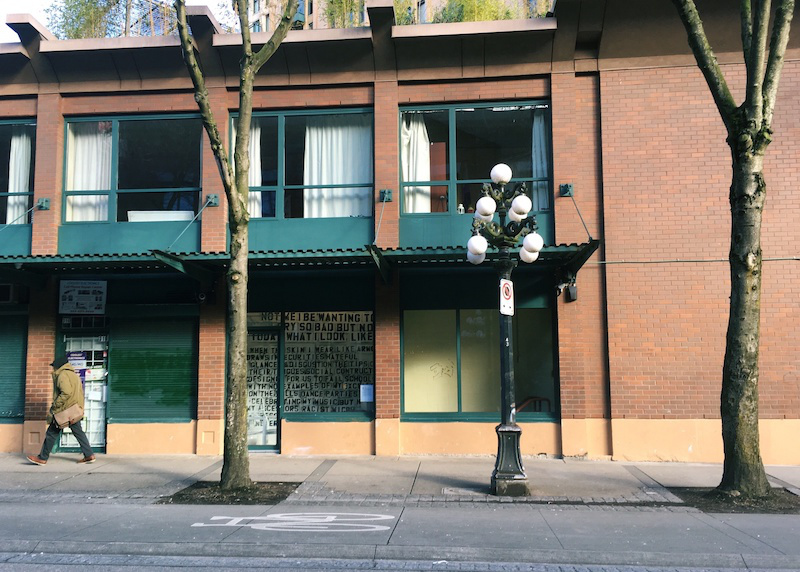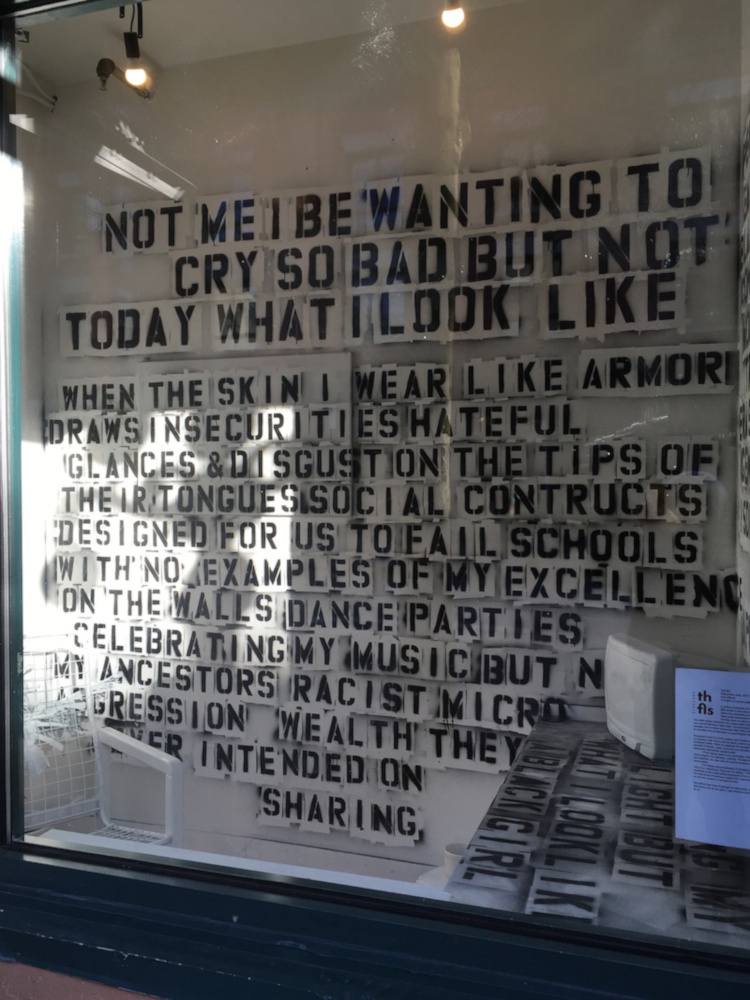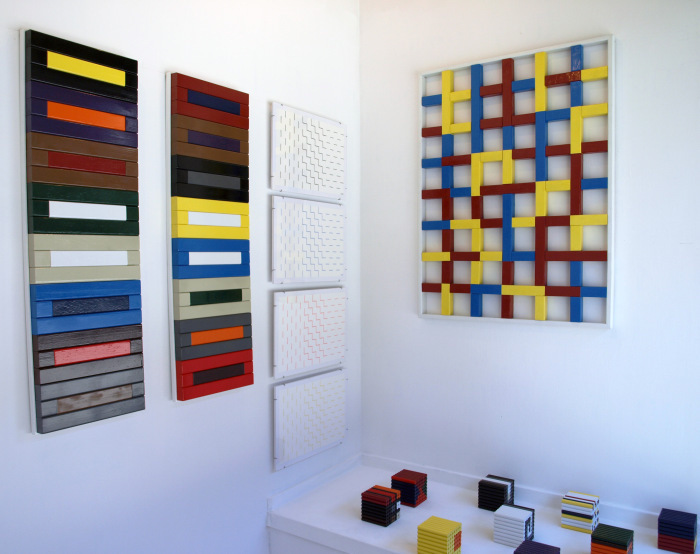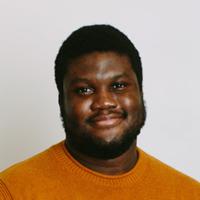Come by the Cheeky Proletariat and like most galleries you will see work from a variety of Vancouver artists. But unlike most galleries, the artists and curators can’t invite viewers in to take a closer look at the art. The space is much too small.
The gallery, only a few steps along Carrall Street from Cordova, is an eight-by-five-foot storefront in the heart of Gastown. Because it’s so small, artists who show work there are attentive to how their pieces are perceived by the people walking by.
The work has to be very clear and needs to stand on its own, because the artists and curators can’t always be in the space to give context.
“You have to be really creative in terms of how you use it,” said Nanyamka Lewis, a Trinidadian-Canadian poet whose work “The Feels” was featured in February 2018 as part of a Black History Month installation at the gallery.
“If [audiences] stop and only read two sentences of a 150-line poem, are they going to leave with the same understanding had they read the whole thing?” she said.


Lewis later curated a showcase called Black Arts Gastown that featured the work of four black artists — Pearl Low, Chase Keetley, Gio Swaby and Shahanah Zaynah.
The size of the space isn’t a weakness, but a strength. Artist James K-M, who showed his work New Squares in March 2018 explains that the space’s square footage makes it very intimate. “You can’t stand back and you can’t get up close, either. There’s a creative tension to that. The space creates something that can’t be created in a traditional gallery.”
When artists approach gallery owner Anthonia Ogundele and talk about setting up tables in the Cheeky Proletariat, she often jokes, “Have you been there? Do you know what it looks like?”
The space was originally part of a Carrall Street condo unit that had been blocked off and unused for years. In 2015, Ogundele and her husband Denis tore down the grate and offered the space to anyone who wanted to use it.
The first thing that went up was not art, however, but a bunch of bad dad jokes that Denis printed from baddadjokes.com and stuck on the window.
“We walked by it a number of times, and you would just see people just standing in front of the storefront laughing their butts off because they were reading all of the different jokes on the window,” said Ogundele.
Through word of mouth, their gallery website and even via sticky notes tacked onto the door, artists reached out to Ogundele to ask about presenting their work in the space. Since the gallery’s launch, 22 artists and curators have shown their work there.
“For many of the people, either new creatives or established artists, they haven’t had opportunities to really present their work or express their ideas where there is a desire to make it more accessible,” said Ogundele.
“So the concept of it being called the ‘Cheeky Proletariat’ speaks to our vision of providing an accessible and inclusive space of free expression for all people.”
One of the recent works featured in the gallery was inspired by a book club reading list. Another was an installation of a little boy’s bedroom by artist Katrina Grabner, called My Blue Bucket of Gold.
The “where are you from” project, which Ogundele curated with Floyd Sandiford, Benny Etienne and Shahanah Shivji, involved 50 members of Vancouver’s black community entering the gallery space one at a time to write on the walls about their experiences in dealing with the question of their origins.
“That, I think, transformed it from... being a very stationary space to one that could be used to interact with the community in a very intentional way,” said Ogundele.
When artist Lewis moved to Vancouver in 2017, she started looking for her community. She followed black people on social media, searched for black community specific hashtags and looked for Facebook groups.
It’s not like there’s a brick-and-mortar centre that you can walk into and find everybody, she said. “If you are a creative, the fastest way for you to find people that do like-minded things, better specifically, within your community, obviously my community being the black community, would be to reach out to other artists and to other creatives and see, you know, where are they showing? What are they showing? What are we thinking? What are we talking about? What are we rallying around?” she said.
Lewis’s work “The Feels” was a poetry installation that focused on mental health, a sensitive subject in an “extremely vulnerable” medium, she said. In showcasing it, she wanted to work with someone who was less likely to misunderstand her work and monetize her words, and was also interested in her development as an artist. And she wanted her work and the attention that it would bring to support the Vancouver black community.
For her, finding a black-owned space was not only important — it was non-negotiable.
“We absolutely have to be in charge of our own narratives and in control of how we choose to represent ourselves,” said Lewis. “If we don’t, we run the risk of misrepresentation or inauthenticity or us just feeling like an afterthought or something to be consumed.”
“It’s important that we have a part in the creation, and that we own it and that we’re recognized for it.”
Lewis believes that having communities and cultural hubs that are owned, managed and curated by marginalized communities will enable a new level of diversity and representation.
“Only we know what we want. Only we know what authentic feels and looks like for us,” she says.

For Christmas in 2017, Ogundele wanted to do something unconventional with the space — a Christmas window. She turned to James K-M, who was her neighbour and lived right above the gallery, for some help.
The conceptual theme was “white,” and it initially involved putting three copies of the Beatles’ White album and 10 bars of Costco soap in the window.
One evening, Ogundele and James K-M served hot apple cider to passersby and invited them to donate white objects to the installation. From panda ears to brushes, people provided an array of different objects. One individual even contributed his shirt to be displayed in the window.
“Everyone was a part of it. When they walked by on the street, they’re able to point to what they contributed to the art piece,” says Ogundele.
James K-M noted that it is rare to find that level of authenticity from a commercial or even artist-run gallery.
“The artist has to be exhibiting for the right reasons and with the right intentions,” he said. “You’re not trying to get famous, you’re not trying to sell — you’re just trying to do something for the audience inside yourself.”
The gallery transforms its part of Carrall Street into a public space. “Having a space in the city is very important for being able to ground people in a city and art as a means of either creating culture or provoking broader narratives,” explains Ogundele. She believes there should be more spaces available to underrepresented artists.
“My husband, my family and I, we have the privilege of owning space in a city that is deeply unaffordable,” said Ogundele. “And I think with privilege, there comes a responsibility to not just improve kind of your own life but to be able to empower and build the capacity of those that are around you.”
Both Ogundele and her husband want to see how they can further leverage their small space to support other creative opportunities.
“I’m really interested to see how this space can offer a small seed for larger impacts, not only in the lives of the people that interact with it, but also how it can make an impact in [the] community.”
Ogundele wants to challenge people who own different kinds of spaces in Vancouver to reimagine what the city could look like if these sites were made available to artists.
The Cheeky Proletariat is a strong example of a gallery that can “express big ideas and create big impact” with limited resources.
It might be just a storefront window, but sometimes a window is all you need. ![]()















Tyee Commenting Guidelines
Comments that violate guidelines risk being deleted, and violations may result in a temporary or permanent user ban. Maintain the spirit of good conversation to stay in the discussion.
*Please note The Tyee is not a forum for spreading misinformation about COVID-19, denying its existence or minimizing its risk to public health.
Do:
Do not: